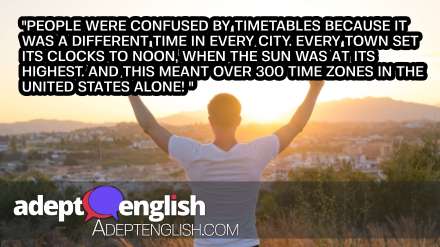Interesting English Speaking Topics
I don’t know if it was thinking about how to the British talk about time in last week’s English speaking lesson or because of something I saw on the news. However, today the learn to speak English topic has a time theme as it is on time zones.
Given how much time zones affect us, we hardly give them any thought. I can sit down to breakfast and be watching something happening live on the news happening in a country which is dark because it’s nighttime, and I barely think about what that means. As I type this English lesson out on my old laptop people are sleeping, some are already a day ahead of me and it’s not until I get on a plane do I even think about what this means for me.
I hope today’s lesson topic helps explain why time zone exist and how they came about. As always, this lesson, and others like it, is really about learning to speak English. We pack the lesson with everyday English vocabulary and while you listen; you are training your brain to recognise, comprehend and store this vocabulary in your longer term memory, ready for automatic recall.
If you want to learn more about how our lessons work and why a listen and learn approach to learning English is a more efficient way of learning to speak English, then you can read more about it here.
Most Unusual Words:
Gump
Wiggles
Conformism
Most common 2 word phrases:
| Phrase | Count |
|---|---|
| Time Zones | 26 |
| The World | 10 |
| The Uk | 7 |
| Of Longitude | 7 |
| For Example | 6 |
Listen To The Audio Lesson Now
The mp3 audio and pdf transcript for this lesson is now part of the Adept English back catalogue . You can still download and listen to this lesson as part of one of our podcast bundles.Transcript: Today We Learn About Time Zones As We Learn To Speak English
Hi and welcome to this podcast from Adept English.
‘Life is like a box of chocolates’ said Tom Hank’s character in the film Forrest Gump. ‘You never know what you’re going to get’. And so it is with our Adept English podcasts. Often I don’t know what you’re going to get until I start writing it! If you like our podcasts, then don’t forget that you can buy them in packs of 50 podcasts for a small fee on our website at adeptenglish.com.
Boost Your Learning With Adept English
Just imagine 50 Adept English podcasts on such a variety of topics as we cover, all aimed at helping you with English speaking? That’ll help you improve your English speaking skills.
Practise your English with history, geography and time zones
Another saying is ‘Variety is the spice of life’. So let’s be spicy today and go with a bit of geography, history and time zones. This is ‘international’ in flavour, so hopefully interesting for all of us. And the purpose is of course, to give you practice with a certain set of words, a certain vocabulary and it will give you practice with country names, which may be different in English from what they are in your language. Here goes.
Daylight Savings – the clocks go back
Well, we’re midway through October now and we’re heading towards the point when the clocks change – that’s in the UK anyway. We will move on 24th/25th October back to GMT or Greenwich Mean Time. We’ve been an hour ahead on BST or British Summer Time since last March and moving the clocks back to GMT will make it dark earlier in the evening and light earlier in the morning.
So this is known as ‘Daylight Saving Time’ in the US and around the world – and many countries do something similar, to try to maximize the number of hours of useable daylight. That also means that you ‘make savings’ by not having your electric lights on for as long. My brain used to have trouble with the clock change, but now I do remember it as the October time change is the nice one, where you get an extra hour, possibly even an extra hour in bed.
And the one in March is less pleasant, where you’re robbed of an hour. So ‘daylight saving time’ happens in North America and Europe – but not so much in the southern hemisphere. And it wouldn’t make sense at the equator, but in the southern hemisphere, only Paraguay, Chile, parts of Australia and New Zealand do it. Russia, China, Africa and most of south America don’t do daylight savings.
The Standardization of International Time Zones 1884
So international time zones were standardized, back in 1884 because different times across the world were causing problems. For example, long distance rail travel in the United States had started to happen across the states, and it became complicated because of all the different local time zones.
People were confused by timetables because it was a different time in every city. Every town set its clocks to noon, when the sun was at its highest. And this meant over 300 time zones in the United States alone! No wonder it was confusing! And as shipping became more international, the need for internationally understood time zones became a necessity. So a conference – that means a big meeting – a conference was organised in 1884. The International Meridian Conference met to determine official time zones around the world and to ‘standardize time’.
📷
A photograph of a man with the sun shining brightly overhead, which is how most places around the world set their time prior to the time zone standard.
‘To standardize’ means ‘to make something standard’ – so that it’s measured, calibrated in an agreed way. Like the whole system of weights and measures – kilogrammes, pounds and ounces, metres and feet. They’re all the same wherever you are in the world – they’re ‘standardized’. So it was decided that the Greenwich Meridian would be used to standardize time. If you’re ever in London and you get chance, that’s if we’re ever able to be tourists again of course, it’s interesting to visit the Greenwich Observatory in East London.
You can get there on the tube. Notice pronunciation there ‘Greenwich’ though it’s spelt G-R-E-E-N-W-I-C-H. And an ‘observatory’, O-B-S-E-R-V-A-T-O-R-Y, is a place where you can ‘observe’, you can look at stars and planets. And at the Greenwich Observatory, you can actually see the Greenwich Meridian, which is where Greenwich Mean Time, and the system for international time zones originates.
Lines of longitude determine time
So if you look at a world map, with time zones marked, you can see vertical stripes, which contain countries within the same time zone. ‘Vertical’, V-E-R-T-I-C-A-L means ‘up and down’. So on the world map the vertical or up-and-down lines are the lines of ‘longitude’. So if you take the UK in the winter months, we’re GMT or Greenwich Mean Time – and that’s the same for countries at the same longitude – so Portugal, the Canary Islands and countries in Western Africa, like Mali, Senegal, Guinea, Ivory Coast. So the Greenwich Meridian in East London was chosen as the new standard time, GMT – Greenwich Mean Time, so all time zones are expressed as GMT plus or minus a number of hours. So for example, Paris is GMT+1 and New York would be GMT -5.
So the idea was that these vertical stripes, these lines of longitude, these meridians, would be used to standardize times across the world. And on the whole, this works. Even when daylight savings were introduced – so a different time for summer and for winter, time zones still remained standard and therefore understandable in most of the world. And the movement of clocks for daylight savings in most areas happens around the same time of year.
So you might be familiar with different time zones because of your work. I know people in the UK for example, who work a late day, because they have to fit in with their US-based clients. So they might take the morning off, and work later in the evening to fit with the different time zone.
Video
Where time zones don’t follow lines of longitude – countries that span time zones
But despite the standardization of time zones, some countries make their own decisions about time. For example, China is so vast that it covers five time zones and yet it keeps the same time across all of its territory. This means that there’s a difference of up to four hours between different parts of China for when the sun rises or the sun sets. It also means that the biggest time change when you cross a border is 3½ hours if you go from China to Afghanistan.
Greenland takes the same approach – more or less. Apart from a couple of tiny parts, Greenland keeps the same time across its whole territory, even though it’s so big, it spans five time zones. And Iceland, though its longitude suggests GMT-1 hour, prefers to have GMT as its time zone, so it’s the same as the UK. I’m sure that’s not the reason, but what I mean is, it is the same as the UK!
Countries with different time zones and where time zones go with geography
Most large countries or territories, which cover several lines of longitude, several meridians have different time zones. So if you’re in Russia for instance, you’ll be in one of eleven time zones. And there are plenty of places in the world, where geographical borders influence the time zone, rather than it sticking exactly to the lines of longitude.
For example, Argentina shares the time zone of Eastern Brazil, that’s GMT-3, even though longitude-wise, it would sit naturally with Paraguay, Bolivia and Venezuela at GMT-4. And parts of Argentina, in terms of longitude, are far enough west to sit with New York time, GMT-5 – along with parts of Canada, Peru and Colombia. But even Chile which is further west than Argentina is only GMT-4. So there are some curious wiggles in the time zones.
Slightly odd time zones
In the UK, we like a bit of non-conformism – someone who doesn’t go with the norm! And there are some time zones that are definitely non-standard. What about Australia? Well, Sydney and Melbourne go with GMT+10 according to their location. But then the middle of Australia, so Alice Springs and the rest is GMT+9½.
Download The Podcast Audio & Transcript
And western Australian, is GMT+8, plus 8 hours as you’d expect, apart from a tiny area in the south, which is GMT+ 8¾ hours. Mmm - strange?! Other countries who don’t like to conform – India is at GMT+5½, Burma is GMT +6½. Afghanistan is GMT+4½, Iran GMT+3½ and Nepal GMT+5¾ hours. So I guess international time is not that standard then.
And right by the International Date Line?
What about the bit at the edge of most time zone maps, where GMT-12 and GMT+12 meet? This is called ‘The International Date Line’ – where it’s so far round the world, it’s kind of the next day. Well, I have trouble dealing with daylight savings timings in the UK, so this is confusing for me! Take for example Samoa, a country in just this area.
In 2011, Samoa decided it had closer ties with Australia and New Zealand, so it agreed to lose a whole day, in order to bring its time more in line with those countries. So it jumped across the International Date Line and moved from GMT-11 to GMT+13. This left American Samoa, which is only 30 miles away, a full day behind – the same time on the clock, but a different day.
I don’t know about you, but that’s more than my little brain can cope with, so I’m going to stop there. There we have it – Standard International Time Zones – and a bit about how they’re not always very standard. Hopefully some useful vocabulary there for you, some practice with the names in English speaking parts of the world for different countries and some interesting ideas. Simple secrets to instantly improve your English? Well, listen to Adept English, of course!
Goodbye
Enough for now. Have a lovely day. Speak to you again soon. Goodbye.











